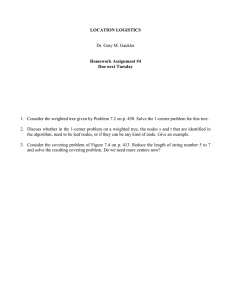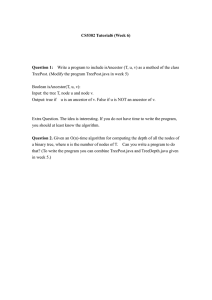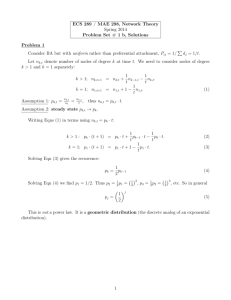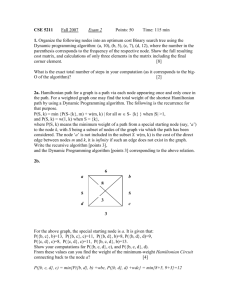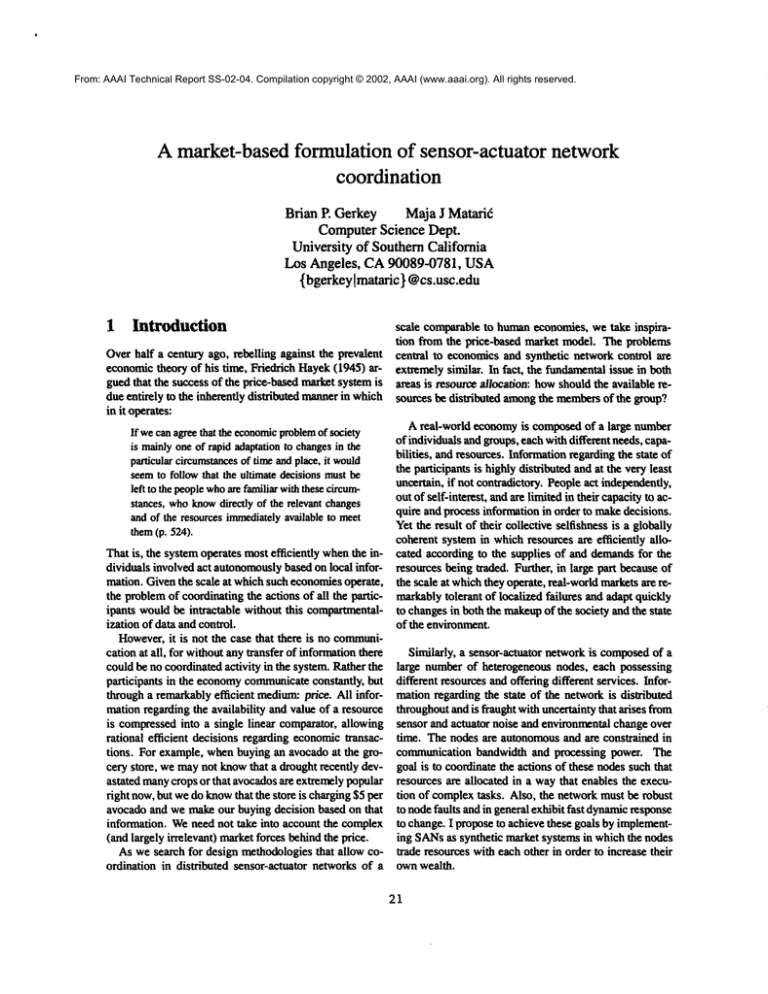
From: AAAI Technical Report SS-02-04. Compilation copyright © 2002, AAAI (www.aaai.org). All rights reserved.
A market-basedformulation of sensor-actuator network
coordination
Brian P. Gerkey
Maja J Matari6
Computer Science Dept.
University of Southern California
Los Angeles, CA 90089-0781, USA
{bgerkey[mataric} @cs.usc.edu
1
Introduction
scale comparableto humaneconomies, we take inspiration from the price-based market model. The problems
Overhalf a century ago, rebelling against the prevalent central to economicsand synthetic networkcontrol are
economictheory of his time, Friedrich Hayek(1945) ar- extremelysimilar. In fact, the fundamentalissue in both
gued that the success of the price-basedmarketsystemis areas is resourcea/location: howshouldthe available redue entirely to the inherently distributed mannerin which sources be distributed amongthe membersof the group?
in it operates:
A real-world economyis composedof a large number
If wecanagreethat the economic
problem
of society
of
individuals andgroups,each withdifferent needs, capais mainlyoneof rapid adaptationto changesin the
bilities,
andresources. Informationregardingthe state of
particular circumstances
of timeandplace, it would
the
participants
is highly distributed andat the veryleast
seemto followthat the ultimatedecisionsmustbe
uncertain,
if
not
contradictory. Peopleact independently,
left to the peoplewhoare familiarwiththesecircumout
of
self-interest,
andare limitedin their capacityto acstances, whoknowdirectly of the relevant changes
quire
and
process
information
in order to makedecisions.
and of the resourcesimmediately
availableto meet
Yet
the
result
of
their
collective
selfishness is a globally
them(p. 524).
coherent systemin whichresources are efficiently alloThat is, the systemoperates mostefficiently whenthe in- cated according to the supplies of and demandsfor the
dividuals involvedact autonomously
basedon local infor- resources being traded. Further, in large part becauseof
mation. Giventhe scale at whichsuch economiesoperate, the scale at whichthey operate, real-worldmarketsare rethe problemof coordinatingthe actions of all the partic- markablytolerant of localized failures and adapt quickly
ipants wouldbe intractable without this compartmental- to changesin both the makeupof the society and the state
ization of data andcontrol.
of the environment.
However,it is not the case that there is no communication at all, for withoutanytransfer of informationthere
Similarly, a sensor-actnator networkis composedof a
could be no coordinatedactivity in the system.Ratherthe large numberof heterogeneous nodes, each possessing
participants in the economycommunicate
constantly, but different resourcesandoffering different services. Inforthrough a remarkablyefficient medium:pr/ce. All infor- mationregarding the state of the networkis distributed
mationregarding the availability and value of a resource throughoutand is fraught with uncertaintythat arises from
is compressedinto a single linear comparator,allowing sensor and actuator noise and environmentalchangeover
rational efficient decisions regarding economictransac- time. The nodes are autonomousand are constrained in
tions. For example,whenbuyingan avocadoat the gro- communicationbandwidth and processing power. The
cery store, we maynot knowthat a drought recently dev- goal is to coordinatethe actions of these nodessuch that
astated manycrops or that avocadosare extremelypopular resources are allocated in a waythat enables the execuright now,but wedo knowthat the store is charging$5 per tion of complextasks. Also, the networkmust be robust
avocadoand we makeour buying decision based on that to nodefaults and in general exhibit fast dynamicresponse
information. Weneed not take into account the complex to change.I proposeto achievethese goals by implement(and largely irrelevant) marketforces behindthe price.
ing SANsas synthetic marketsystems in whichthe nodes
As we search for design methodologiesthat allow co- trade resourceswith each other in order to increase their
ordination in distributed sensor-actuator networksof a ownwealth.
21
whichthe nodescommunicate.Theseservices are offered
by providers:
In this paper we expoundon this economicanalogy by
constructing a market-basedmodelof sensor-actuatornetworksand showinghowit can be used to achieve scalable
coordination.The rest of this paper is organizedas follows: Section 2 formally states the coordinationproblem,
Section3 justifies a market-basedsolution, Section4 explains howperformanceis measured,Section 5 describes
our marketmodel,and Section 6 concludeswith a discussion of future work.
2
Definition 4 Service provider (or simply provider): one
or morenodesthat offer a service.
ProblemDefinition
EachproviderPi E P, the set of available providers, is a
subset of the set of nodes N. That is, a service maybe
provided by a single node or by a group of nodes, also
knownas a coalition. A node n~ E N can be a member
of more than one provider; ni is generally a memberof
at least the solo provider{hi} (assumingthat n~ can provide someservice(s) on its own).Beinggeneric, a service
cannot be directly executed;rather it mustbe madeinto a
specific task:
The question with which we are concerned is the following: howcan coordinated, task-oriented behavior be
elicited from multi-purposephysical sensor-actuator sys- Definition 5 Task: A task t~ is a parameterizedinstance
tems? Wenowformalize this question, first with some of a service sj E S, denotedby ti "~ sj.
underlyingdefinitions, then witha statementof the probFor example,a generic object transportation service can
lem.
be madeinto a task of the form"transport the orangeball
from RoomA to RoomB now" For evaluation purposes,
Definition 1 Sensor-actnator node (or simply node):
computerthat is physically embodiedin its environment the performanceof each task t~ can be measuredby a metthrougha set of sensorsand/oractuators, referred to col- ric function mi:
lectively as resources.
Definition 6 Me~cfunction (or simply metric): a function that mapsfroma set of task-specific parameters
to the
Definition 2 Sensor-actuator network (SAN):A set of
real
interval
[0,
oo).
communicatingnodes.
See Section 4 for details on howmetrics are determined.
Everyprovider is capable of estimating its ownperformancefor a given task, both before and during task execution. Theseestimatesare not perfect, but shouldprovide
predictions of performancethat are as accurate as possible.
A node’s surroundingenvironmentis the noisy, uncertain,
non-stationaryphysical world,and the resourcesare physical devices. As a result, the use of a node’s resources
incurs a monetarycost in the real world(e.g., the retail
price of a camera,the energycost of operatinga motor).
Eachnodeis autonomous
and locally controls its resource
set. The nodes are also endowedwith communication
facilities. Every node maycommunicatewith every other
node, but bandwidthis limited and messagesmaybe lost
(thoughthe communication
channelis in general quite reliable) I. Usingtheir resources, nodescan providevarious
services:
Definition3 Service: a generic capability of one or more
nodes.
The ProblemGiven is N, a set of nodes that comprise
a sensor-actuatornetwork,and S, a set of services that the
networkcan provide. Alsogivenis the providerstructure;
that is, the set of providersP is predefinedsuchthat every
node ni E N knowsthree things:
1. the set of providersof whichni is a member
2. the identities of the other members
(if any) of these
providers
In its simplestform,a service will constitute a single action performedby an individual node; moregenerally, it
3. the set of services offeredby eachof these providers.
will constitute a coordinated,time-extendedseries of actions performedby a collection of nodes. Twoexamples Givenan infinite sequenceof tasks T that arrive stochasof a service are transportation of an object and mapping tically over time, the problemis to assign the tasks T to
of an area. The specification of a service is independent the providers P so as to maximize:
of its implementation;thus a service maybe implemented
in several different ways. Together, the set of possible
t~GT
services S constitutes the common"language" through
1 This specification of a communication
systemroughly modelsIEEE That is, the goal is to find allocations that optimizethe
performanceof the SANon the tasks.
802.1 lb wireless Etheroet (IEEE1999).
22
Dueto the non-stationarityof boththe external state of
the worldand the internal state of the nodes, any static
allocation can easily fall into temporallylocal extremaof
2. Thusany effective task allocation policy
performance
must be dynamicin nature and consider re-allocations.
ing. Thusit is important to support the analogy with
moreconvincing evidence. First, markets are extremely
practical for use in large-scale physical systems;the market protocols themselvesare inherently distributed computationally and informationally, and the price information by which individuals communicateis compact.Second, in our prior workwith multi-robot systems (Gerkey
3 Justification for a Market-based & Matari6 2001a, Gerkey & Matari6 2001b, Gerkey &
Matari6 2002), we have shownthat MURDOCH,
a simple
Solution
greedy market-like mechanism
similar to the Contract Net
Anyapproachthat is proposedfor solving this task aiM- Protocol (Smith1980), can robnsdyand effectively allocation problemrequires justification. It should be clear cate tasks in dynamicenvironments,albeit with the danger of falling into temporallylocal minimaof efficiency.
whyexisting approachesare insufficient and whythe new Third, there is a significant bodyof microeconomic
theapproachis expectedto be effective.
ory
dealing
with
general
equilibrium
that
can
provide
cerVariants of the embodiedcoordination problem have
tain
guarantees
about
the
quality
of
allocation
solutions
faced researchers since the advent of multi-robot systems
derived from properly constructed (non-greedy) market
(e.g., Matari~(1992), Parker (1994)). Whilea number
systems(see Section 5 for details). Finally, there is the
ad-hoccoordination strategies havebeen proposedin the growingbody of work on computational markets, which
roboticsliterature, an effective, efficient, general-purpose showsthat they can be used to solve manydifferent reapproachto task allocation is yet to be seen. Among
those
approachesthat havebeenvalidated, there are indeed in- sourcatask allocation problems (e.g., Kurose &Simha
(1989), Gagliano, Fraser & Schaefer (1995)); however,
teresting examplesof coordination. However,
few, if any,
aside from our own work with MURDOCH,market mechof those systems have ever been re-used and there still
does not exist any consensusin the community
as to how anismshaveyet to be studied and empiricallyvalidated in
embodieddomains,whichis our current goal.
goodcoordination mechanisms
should be designed or implemented for embodieddomains. Thus, from the point
of viewof robotics in particular and embedded
systemsin
general, group-levelgeneral-purposetask allocation is an 4
Measuring Performance
open problem.A great deal of work on related problems
in task and resource allocation and teamworkhas been Objectivelyevaluating solutions to the giventask allocadone in the software multi-agent community(e.g., She- tion problemis non-trivial, but such evaluationis neceshory & Kraus0995), Sycara, Decker, Pannu, Williamson sary in order to comparethe "goodness"of different aUoet ai. (1996), Walsh& WeUman
(1998), Martin, Cheyer cations. Asstated in Section2, the overall performance
of
&Moran(1999)), sometimesusing the software environ- an allocation will be determinedas a sum3 of the performerit as a substitute for the physical world(e.g., Tambe mancevalues of the individual tasks, both past and cur(1997), Modi,Jung, Tambe,Shenet al. (2001)). As
rent.
experts with respect to these approaches,we are not in
Havingdecidedhowto combineindividual task perfora position to decry themas ineffectual in embodieddo- mancevalues, there remains the problemof determining
mains. In fact, any of these (and other) methodscould those values. Wesuggest that in this domain,performance
eventually be quite successful in coordinating physical in the context of an single task has twocomponents:
qua/systems. Howeverthese software agent approaches (in ity andcost. Qualityis a measureof howwell the task is
general) havenot yet beenphysically validated at all and executed. For example,in an object transportation task,
it is not clear whetheror whenthat validationwill occur. quality mightbe the time required to transport the object
As for whyone should expect our proposed market- or the accuracy with whichit is transported, given some
based mechanismto be effective for the embodiedtask target location or trajectory. Cost is a measureof the reallocation problem,there are several reasons. Thereis, sources used in achievingthe task. As mentionedearlier,
of course, the analogy given in Section 1: people con- the sensors and actuators that are used to do workin this
stantly and efficiently allocate scarceresourcesusing var- domainhave associated with themreal costs in the physious formsof the price-basedmarket,so artificial systems ical world. Returningto the object transport task, cost
should do the same. However,an analogy on its ownis
3Insteadof a simplesum,overallperformance
couldin generalbe
an insufficient justification and can, in fact, be misleadanyarbitraryfunctionof individualtaskperformances.
Forexample,
2Wemake
the reasonable
assumption
that perfectknowledge
about if thereexistsa known
priorityamong
the tasks, thena weighted
sum
futurestatesof theworld
is unavailable.
mightbe a bettermeasure
of overallperformance.
23
mightbe the amountof energy required to powerthe motors that drive the transportingrobot’s wheels.
Unfortunately for the goal of evaluation, we are now
faced with a multi-objective problem: maximizequality
andminimizecost. Qualityand cost can easily be in direct
conflict, such as whenan object can be transported more
quickly but more expensivelyby a large rocket-powered
robot than by a small battery-poweredrobot. In general,
the systemevaluator mustmakea decision as to the relative importanceof quality and cost in measuringperformance.At one extreme, pure cost-minimization suggests
the solution in whichno tasks are allocated and thus no
resourcesare used. Pure quality-maximization
will result
in a better but still undesirablesolution in whichtasks are
well executed, but without regard for the costs imposed
on the external world, whichmayplay a very real role in
the long-termsurvival and operationof the system.
Clearly there are manypossible schemesfor mixing
quality and cost betweenthese two extremes. Although
we are exploring this space to somedegree we do not attemptto define the best possible mix. Rather we look for
performancemeasures that combinequality and cost in
sucha waythat the results are intuitive andmeaningfulfor
the particular task and domain.By combiningthese individual measures,we can construct an objective, external
metric of system-level performancefor use in experimental comparisonof different allocation mechanisms(see
Section6).
5
The Market Model
5.1 Background
MURDOCH
(Gerkey & Matari6 2001b), being a singleshot task allocator similar to the Contract Net Protocol
(Smith 1980), is only loosely based on economicideas
and suffers from well-knownproblemsof efficiency commonto such myopic, greedy systems. By contrast, we
nowpropose a marketformulation of the task allocation
problemdescribed in Section 2 through the application
of general equilibrium theory (Varian 1992). In an economycomprising multiple interconnected markets, general equilibrium(or Walrasianequilibrium)is the state
which supply and demandare in balance simultaneously
in all markets, given utility-maximizingbehavioron behalf of all participants. Suchan equilibriumis described
by a vector of prices assigned to the markets. Animportant and appealingcharacteristic of a general price equilibriumis that the resultant resourceallocation is Pareto
efficient; that is, to better the situation of oneindividual
will necessarily worsenthe situation of another individual. Whensolving multi-agent problems(especially in
economics),Pareto efficiency is often the stated goal, be-
cause
it is "besf’ in the sensethat it is not possibleto improveupona Pareto efficient solution withoutmakingrelative value judgmentsabout the individuals involved.
Given the goal of general equilibrium, a methodis
required to find it. The original proponentof general
equilibrium, the Frencheconomist Wairas(1954), suggestedthat it couldbe achievedthroughan iterative priceadjustment process, whichhe termed tat~)nnement. The
idea is as follows (as summarizedby Cheng&Wellman
(1998)):
Startingwitha set of pricesarbitrarilygiven,the excess demand
in eachmarketmaybe positive, zero,
or negative.Foran arbitrary orderingof these markets, take the first andadjustthe priceso that supply anddemand
are equal,givenall other prices. Of
course,the changein the first price will normally
changeexcess demandin all other markets. Next
considerthe secondmarketand likewiseadjust its
price to clear; then repeat the processfor all remainingmarkets. At the end of each round, only
the last marketis guaranteedto be in equilibrium,
since a changeof price in somalater marketswill
normally
destroythe equilibriaestablishedin previousmarkets.But Walrasarguedthat the changein a
good’sownprice will havea moresignificantimpact
on its excessdemand
than the changein other goods’
prices. Theownprice adjustmentgoes directly to
zero excessdemand,
whereasthe indirect influences
of other price changesmayincreaseor decreasederoa__ndfor the good,andwayevencanceleachother
out. Hence,Walrasargued,it is probablethat after eachround,the prices are closerto equilibrium
thanbefore.Eventually,
in this story, all markets
will
clear.
Theexistence and uniquenessof general equilibria in markets has beenstudied by economistsat great length since
Walras’stime. In brief, a generalequilibriumwill exist if
individual preferences are convexand continuous. A general equilibriumwill be uniqueif the goodsbeing traded
inthemarkets
aregross
substitutes;
that
is,anincrease
in
theprice
ofonegoodincreases
(oratleast
doesnotdecrease)
thedemand
forother
goods.
5.2 Model
Usinggeneral equilibrium theory, we are constructing a
market-basedmodelthat describes the embodiedallocation problemgivenin Section2 andsimplifies its solution.
Constructionof the modelwill be an ongoingand iterative
process; thus the expositiongivenhere is necessarilypreliminary. Further analysis and experimentationwill suggest modificationsto the model,as well as answersto the
list of remainingquestionsgivenin the next section.
In modelingthe problem,wetreat the nodesin a sensoractuator networkas competitive4 self-interested individuals participating in an economyof task contracts. The
economyis composedof multiple markets, one for each
available task contract. The providers vie for the contracts by auction, submittingbids basedon their expected
performance. For the purposes of this model, performancevalues are formulated such that they range from
0, the best, to co, the worst. Thus, although they incorporate measurementsof quality, performancevalues
can be teated like costs, whichare incurred by providers
whenexecutingtasks. After task execution, a provider is
paid a sumof moneyin compensation,and the provider’s
profit is the difference betweenthat paymentand its performance.Task contracts are auctioned according to the
following algorithm:
Whenis an auction held? An auction should be held
whenever
there is a high probabilitythat a re-allocation of
tasks will result in an increaseof systemperformance.Althoughit mightbe possible, in principle, to build a model
of the worldin order to determinethis probability formally, we will employa simple and intuitive event-driven
scheme.A newauction will be called as a result of the
occurrenceof any "important"event, the set of whichwill
include at least: the arrival of a newtask and the completion of an old task. Other importantevents could be
passageof time and lack of progresson one or moretasks.
Whoacts as auctioneer?. In principle, any node can be
auctioneerat any time; in practice there will likely be a
set of designatedand well-known
auctioneer nodes. Since
computationand communication
will not scale if a single
I. Aninitial vector of prices representing the amount nodesimultaneouslyhandles all allocations, the markets
of moneyto be paid for the successful completionof themselveswill be distributed amongmultiple auctioneers
each task in the set of currendyavailable tasks T is whenthe economycontains manytasks.
distributedto the providers.
2. Eachproviderp~ 6 P considers its possibilities. For Howare the initial price vectors determined? Aleach task tj E Ti, whereTi is the subset of T that though Walras imaginedthemas random,initial prices
contains only those tasks of whichPi is capable, Pi could be purposefullybiased, for at least tworeasons. On
estimate the
estimates its performance,building a vector of per- the one hand, if the auctioneer can somehow
final
price
for
a
task,
then
setting
the
initial
price accordformancevalues. By subtracting this performance
ingly
will
speed
convergence
to
equilibrium,
thus shortvector fromthe givenprice vector, Pi determinesits
ening
the
time
required
to
complete
the
auction.
Alternaexpectedpayoff for each task. In an attempt to maxtively,
if
there
exists
a
relative
priority
among
the
tasks,
imizeprofit, Pi choosesthe task with the highest exinitial
prices
could
be
skewed
so
that
more
money
is
of.
pectedpayoffand bids for that task.
feted for higher-prioritytasks.
3. Prices are adjusted in a tat6nnement-likeway:when
morethan one provider is willing to execute a task Whoparticipates in an auction? Not every provider
(i.e., demandexceedssupply), the price is lowered will participate in everyauction,for tworeasons.First, in
(in an effort to find the lowest, or best performing, order to scale to very large systems, auctions will genbidder), and vice versa. Thenewprice vector is re- erally be confined to a subset of physically collocated
distributedto the providers.
providers, because, considering the energy cost and po4. Steps 2 &3 are repeateduntil equilibriumis reached, sitional uncertainty involvedin long-distancemovements,
at whichtime the marketsare cleared, with eachtask far-awayproviders are unlikely to performwell. Second,
allocated to a provider (assumingthat the network a providermaychoosenot to participate in an auction if
it is heavily invested in (and makingprogressat) its own
containssufficient resources).
task. Shouldan already-engagedprovider decide to parTheresulting allocationwill be Pareto-efficient,subject to ticipate in an auction, it mustconsiderits sunkinvestment
uncertainty in performanceestimation.
in its current task whenestimating performanceon other
5.
tasks
5.3 Remaining Questions
Wehave been purposefully vague regarding several im- Whomonitors task progress? Progress monitoring
portant issues of this modeland algorithm,for weare cur- will be essential for good system performance, and
rently investigating howto best resolve them. Wepresent each provider will monitorits ownprogress throughrethese issues nowas questions, with preliminaryanswers. estimation of performance.However,since nodesare subject to fault and failure, progressshouldalso be monitored
4Inaneconomic
context,a competitive
individualis onewhotakes
tasksin Kurose
&Simha’s
(1989)systemmakesimpriceinformation
as given,as opposed
to a strategicindividual,who 5Computational
speculates
ontheeffectsof his own
actionsonprices.
ilardecisions.
25
externally. As for who performs this external monitoring,
several schemesare possible, such as a predefined set of
dedicated monitors or an egalitarian peer-to-peer system.
Gerkey,B. P. & Matari~, M. J. (2001a), Principled communication for dynamicmulti-robot task allocation, in D. Rus&
S. Singh, eds, ’Experimental Robotics VII, LNCIS271’,
Springer-Verlag Berlin Heidelberg, pp. 353--362. (ISER
2000).
Gerkey,B. P. & Matari~,M. J. (2001b), Sold!: Marketmethods
for multi-robot control, TechnicalReportIRIS-01-399,Institute for RoboticsandIntelligent Systems,Schoolof Engineering, Universityof SouthernCalifornia.
Gerkey,B. P. & Matari~, M. J. (2002), Pusher-watcher:Anapproachto fault-tolerant tightly-coupledrobot coordination,
in ’Proc. of the IEEEIntl. Conf. on Roboticsand Automation (ICRA)’,WashingtonD.C. To appear.
Hayek, E A. (1945), ’The Use of Knowledgein Society’, The
AmericanEconomicReview 35(4), 519-530.
IEEE (1999), Wireless 1.ANMediumAccess Control and Physical LayerSpecifications. IEEEStd 802.11b-1999.
Kurose, J. E &Simha, R. (1989), ’A microeconomicapproach
to optimalresource allocation in distributed computersystems’, IEEETransactionson Computers38(5), 705--717.
Martin, D. L., Cheyer, A. J. & Moran, D. B. (1999), ’The
open agent architecture: A frameworkfor building distributed softwaresystems’,AppliedArtificial Intelligence
130), 91-128.
Matari~, M. J. (1992), Designing EmergentBehaviors: From
Local Interactions to Collective Intelligence, in J.-A.
Meyer,H. Roitblat &S. Wilson, eds, ’FromAnimals to
AnimaLs2, Second International Conference on Simulation of AdaptiveBehavior(SAB-92)’,MITPress, pp. 432441.
Modi,J., Jung, H., Tambe,M., Shen, W.et al. (2001), A DynamicDistributed Constraint Satisfaction Approachto Resource Allocation, in ’Proc. of the Intl. Conf. on Principles and Practices of Constraint Programming’,Paphos,
How are multi-node providers handled? How does
a node avoid over-commitment? We have designed a
simple 4-step negotiation protocol that occurs amongthe
nodes in the provider (a sort of"huddle") that solves these
problems. For brevity, we leave out the details here.
What about money? Can it be accrued? In the current model, nodes cannot purchase anything with money,
and determining a node’s performance by examining its
accrued wealth involves somewhat circular logic. Thus
there might in fact be no advantage in allowing nodes to
accrue money.
6
Conclusion & Future Work
In this paper we have formally defined an interesting and
open research problem: task allocation in sensor-actuator
networks. We have motivated an economic approach to
this problem and given our own preliminary market formulation based on general equilibrium theory. Weare currently implementingthis model, and our next step will be
to validate it experimentally.
In order to validate our market model, we plan to perCypros.
form experiments with various sensor-actuator networks,
AnArchitecture for Fault
both simulated and real. Initially, we will pursue a multi- Parker, L. E. (1994), ALLIANCE:
Tolerant, Cooperative Control of HeterogeneousMobile
robot foraging domain. Foraging experiments will be carRobots,in ’proc. of the IEEE/RSJ
Intl. Conf. on Intelligent
ried out exclusively in simulation, allowing us to focus on
Robots and Systems(IROS)’, Munich, Germany,pp. 776783.
scaling. Furthermore, it is in simulation where we will
Shehory,
O. &Kraus, S. (1995), Task allocation via coalition
be best able to implement and test non-market allocation
formationamongautonomous
agents, in ’Prec. of the Intl.
mechanisms for comparison purposes. Subsequently, we
Joint Conf. on Artificial Intelligence (IJCAI)’, pp. 655661.
will moveto the physical world and apply our market approach to task allocation in a real instrumented environ- Smith,R. G. (1980), ’TheCot~tract Net protocol’, IEEETranactions on Computers29(12), 1104-1113.
ment, consisting of manymobile robots and fixed sensor
Sycara,
K., Decker,K., Pannu,A., Williamson,M.et al. (1996),
nodes. Using physical hardware, we will focus on the ef’Distributed intelligent agents’, IEEEExpert
11(6), 36--46.
fects of uncertainty, noise, and non-stationarity in the enTambe,M. (1997), Agentarchitectures for flexible, practical
vironment. In both domains, we will perform experiments
teamwork,
in ’Proc. of the Natl. Conf.on Artificial Intelliand explore model paran~terizations that address central
gence (AAAI)’,Providence, RhodeIsland.
issues, especially with regard to when and why market- Varian, H. R. (1992), MicroeconomicAnalysis, 3rd edn, W.W.
Norton & Company,NewYork.
based coordination is applicable to embodiedtask allocation.
Walrus, L. (1954), Elements of Pure Economics, Augustus
M.Kelley Publishers. Originally publishedin 1874.
Walsh,
W.E. & Wellman,M. P. (1998), A MarketProtocol for
References
DecentralizedTaskAllocation, in ’Proc. of the Intl. Conf.
on Multi AgentSystems(ICMAS)’,Paris, France.
Cheng, J. Q. R, Wellman, M. P. (1998), ’The WALRAS
algorithm: A convergent distributed implementationof general equilibrium outcomes’, Computational Economics
12(1), 1-24.
Gagliano, R. A., Fraser, M. D. &Schaefer, M. E. (1995), ’Auction allocation of computingresources’, Communications
of the ACM38(6).
26




